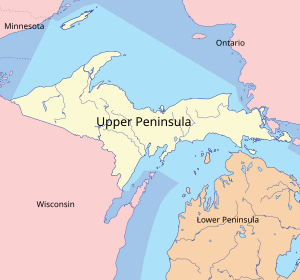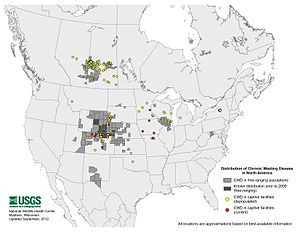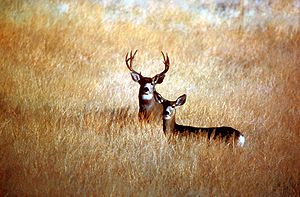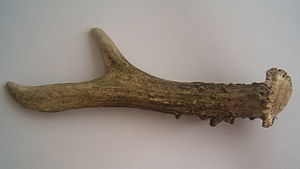 |
| Michigan's Upper Peninsula (Photo credit: Wikipedia) |
Seven Upper Peninsula conservation organizations will receive Deer Habitat Improvement Partnership Initiative grants from the Department of Natural Resources' Wildlife Division in 2012, DNR officials announced today.
The projects, totaling $49,235 of DHIPI grant money, will improve deer habitat in Alger, Chippewa, Delta, Dickinson, Iron, Luce, Mackinac, Marquette, Menominee, Ontonagon and Schoolcraft counties.
The DHIPI grant program is designed to attract and support proposals from non-government organizations interested in improving white-tailed deer habitat in the Upper Peninsula. The competitive grant program, funded by the state's Deer Range Improvement Fund (DRIP), requires the projects be located on non-state-owned land, including private property and Commercial Forest Act-enrolled land.
The 2012 DHIPI grants will go to the following organizations:
- The Bays de Noc Gobblers chapter of National Wild Turkey Federation and Wheelin' Sportsmen will receive $8,700 to partner with Plum Creek Timber Company on creation and enhancement of wildlife openings, along with planting of fruit and nut-bearing trees on five parcels of Plum Creek land in Delta, Menominee and Marquette counties. The project will also create additional opportunities for hunters with a disability.
- The Dickinson Conservation District will receive $8,800 to plant fruit and oak trees on 40 parcels of privately-owned land in Dickinson, Iron and Menominee Counties.
- The Alger County chapter of U.P. Whitetails, in partnership with Forestland Group, will receive $10,000 to plant mesic conifers and oak trees on Forestland Group property where beech trees have been affected by beech bark disease. Approximately 500 acres in Alger, Luce, Schoolcraft and Chippewa counties will receive seedlings.
- Wildlife Unlimited of Iron County will receive $7,500 to partner with the Natural Resources Conservation Service to enhance wildlife openings on seven sites with native prairie and cool season plantings. This project will also provide new opportunities for youth hunters.
- The Ontonagon chapter of Whitetails Unlimited will receive $7,585 for a 10 acre wildlife opening restoration project adjacent to a deer yarding complex.
- Straits Area Sportsmen's Club will receive $6,650 to plant 14 red oak trees (each at least 15 feet tall) on U.S. Forest Service land in Mackinac County.
The six grant recipients were also congratulated by Natural Resources Commissioner J.R. Richardson, Ontonagon, who chairs the Upper Peninsula Habitat Work Group.
"These habitat improvement projects bring real value back to the resource, and I have to thank the sporting groups and community partners for their dedication and involvement," Richardson said. "At the end of the day the real winners are the resources, and isn't that what it all should be about?"
For more information about the Deer Habitat Improvement Partnership Initiative or the DRIP Fund, contact Bill Scullon at 906-563-9247. More information about deer management in Michigan can be found online at www.michigan.gov/deer.
Created by legislation in 1971, the DRIP fund is supported by a $1.50 allocation from each deer license sold (except for senior licenses), which equals $2.2 to $2.8 million in funding annually. This restricted funding is for the enhancement, maintenance, and acquisition of deer habitat statewide.
The Michigan Department of Natural Resources is committed to the conservation, protection, management, use and enjoyment of the state's natural and cultural resources for current and future generations. For more information, go to www.michigan.gov/dnr.












































